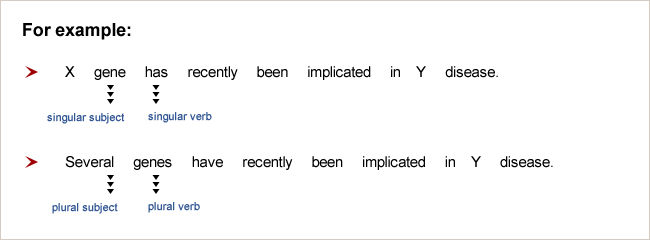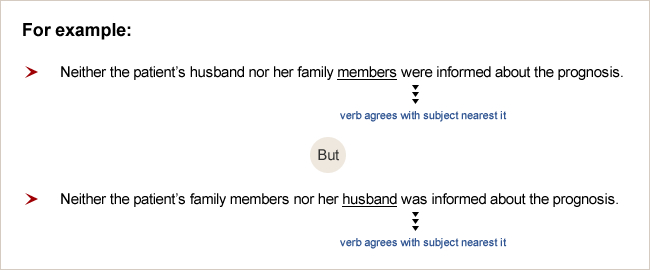SELF-STUDY
Subject-Verb Agreement
The verb in a sentence must agree in number with its subject.

In scientific writing, errors in subject-verb agreement, by native and nonnative authors alike, tend to occur for the following reasons:
(1) MISTAKEN SUBJECT
Intervening words and phrases between the subject and verb distract the author from the real subject of the sentence.

The verb should be ‘were’. The singular noun ‘model’ in the intervening phrase is distracting because it is nearer the verb than the real subject.
(2) FALSE SINGULAR/PLURAL NOUNS
In scientific English, words directly derived from Latin or Greek may cause confusion because the plural of many of these words is not formed by simply adding ‘s’ to the end of the word.

Examples of words with Latin/Greek plural forms:
bacteria
media
phenomena
criteria
protozoa
analyses
pharynges
(singular: bacterium)
(singular: medium)
(singular: phenomenon)
(singular: criterion)
(singular: protozoon)
(singular: analysis)
(singular: pharynx)
Note that words may also be mistaken to be plural because they end in ‘s’ in the singular form.

(3) MULTIPLE SUBJECTS JOINED BY ‘EITHER … OR’/’NEITHER … NOR’
The verb agrees with the subject nearest it (ie, the noun after ‘or/‘nor’).

(4) PARENTHETICAL PLURALS
The verb is singular.

(5) MEASURED ITEMS
The verb is singular.

You try!
Revise the following sentences for subject-verb agreement.
(Sentences are arranged in roughly increasing order of difficulty.)
- 1.
- The tenderness in the left shoulder and paresthesia in the left arm has disappeared, with no recurrence 9 months after surgery.
- 2.
- Several factors during β-cell proliferation has been identified.
- 3.
- The retreatment criteria was not strictly standardized.
- 4.
- High levels of XYZ expression has been reported in colon cancer and breast cancer, as well as in several cancer cell lines.
- 5.
- Data on symptoms, diseases, and smoking habit was assessed by self-administered questionnaire.
- 6.
- The failure of replication in the 3 additional cohorts preclude their robustness in relation with the X-disease susceptibility gene.
- 7.
- The results of the cluster analysis was strongly influenced by the characteristics of the population studied.
- 8.
- Measles are spread through transmission from the nose, throat, and mouth of someone who is infected with the virus.
- 9.
- 50 g of glucose were given orally and blood was collected 1 hour later for glucose estimation.
- 10.
- Neither the medical interns nor their attending physician were consistently accurate in assessing patients’ treatment preferences.
- 11.
- Laboratory tests and brain MRI were unremarkable for X disorder or other generalized disease that cause optic nerve involvement.
- 12.
- X therapy together with intramuscular injection of an endothelial growth factor agent are currently the treatment of choice for Y disease.
- 13.
- In addition, X monotherapy with monthly injections are known to cause an increase in the rate of cerebral infarction.
- 14.
- Very little data is available on the prevalence of eye diseases in young children in sub-Saharan Africa.
- 15.
- In addition, our OCT data was similar to that obtained using the histologic preparation.
- 16.
- Eligible patients were identified in the clinical database of each hospital and the following information extracted from their data.
Answers
- 1.
- The tenderness in the left shoulder and paresthesia in the left arm have disappeared, with no recurrence 9 months after surgery.
- The subject is a compound subject (‘tenderness’ and ‘paresthesia’), so the verb should be plural. The singular noun (‘arm’) of the intervening phrase between the subject and verb could be distracting.
- 2.
- Several factors during β-cell proliferation have been identified.
- The subject of the sentence (‘factors’) is plural, so the verb should also be plural. The singular noun (‘proliferation’) of the intervening phrase between the subject and the verb could be distracting.
- 3.
- The retreatment criteria were not strictly standardized.
-
‘Criteria’ is a plural subject (singular: ‘criterion’), so the verb should also be plural.
(‘retreatment’ is an adjectival form modifying ‘criteria’.)
- 4.
- High levels of XYZ expression have been reported in colon cancer and breast cancer, as well as in several cancer cell lines.
- The subject of the sentence (‘levels’) is plural, so the verb should also be plural. The singular noun (‘expression’) of the intervening phrase between the subject and the verb could be distracting.
- 5.
- Data on symptoms, diseases, and smoking habit were assessed by self-administered questionnaire.
- The subject of the sentence (‘data’) is plural, so the verb should also be plural. (Note that ‘data’ is the plural form of ‘datum’.) The singular noun (‘habit’) of the intervening phrase between the subject and the verb could be distracting.
- 6.
- The failure of replication in the 3 additional cohorts precludes their robustness in relation with the X-disease susceptibility gene.
- The subject of the sentence (‘failure’) is singular, so the verb should also be singular. The plural noun (‘cohorts’) of the intervening phrase between the subject and the verb could be distracting.
- 7.
- The results of the cluster analysis were strongly influenced by the characteristics of the population studied.
- The subject of the sentence (‘results’) is plural, so the verb should also be plural. The singular noun (‘analysis’) of the intervening phrase between the subject and the verb could be distracting.
- 8.
- Measles is spread through transmission from the nose, throat, and mouth of someone who is infected with the virus.
- The subject of the sentence (‘measles’) is singular, so the verb should also be singular. (Note that ‘measles’ is an example of a ‘false plural noun’; ie, because it ends in ‘s’ in its singular [noncountable] form, it may be mistaken for a plural form.)
- 9.
- 50g of glucose was given orally and blood was collected 1 hour later for glucose estimation.
- Even though more than 1 gram of glucose was given, measured items usually take a singular verb. Also note that with the revision, the second ‘was’ may be deleted, as the repetition of the verb is understood. In this case, the sentence becomes: ‘50 g of glucose was given orally and blood collected 1 hour later for glucose estimation.’
- 10.
- Neither the medical interns nor their attending physician was consistently accurate in assessing patients’ treatment preferences.
- In either … or / neither … nor constructions, the verb agrees with the noun nearest it, ie the noun after or / nor. Note that if we change the order of the nouns, the plural verb of the original sentence does not need to be revised: ‘Neither the attending physician nor the medical interns were consistently accurate in assessing patients’ treatment preferences.’
- 11.
- Laboratory tests and brain MRI were unremarkable for X disorder or other generalized disease that causes optic nerve involvement.
- The verb after ‘that’ (‘causes’) should be singular because ‘that’ refers to ‘disease’.
- 12.
- X therapy together with intramuscular injection of an endothelial growth factor agent is currently the treatment of choice for Y disease.
- The subject of the sentence (‘therapy’) is singular, so the verb should also be singular. Note that ‘together with’ is simply a preposition, showing the relationship between ‘therapy’ and ‘agents’. It is not a joining word (in grammar speak, a coordinating conjunction) like ‘and’, so it does not join nouns to form a compound noun. Therefore, because ‘agent’ is linked to ‘therapy’ by a preposition, it is subordinate to it, not an equal subject of the sentence. If the preposition were replaced by ‘and’, ‘agent’ would become a compound subject with ‘therapy’ and the sentence would become: ‘X therapy and intramuscular injection of an endothelial growth factor agent are currently the treatments of choice for Y disease.’ (However, notice that the nuance of meaning has slightly changed, as reflected in ‘treatments of choice’, so strictly speaking, this revision would not be appropriate.)
- 13.
- In addition, X monotherapy with monthly injections is known to cause an increase in the rate of cerebral infarction.
- The subject of the sentence (‘monotherapy’) is singular, so the verb should also be singular. ‘with’ is a preposition, so ‘monthly injections’ is subordinate to ‘monotherapy’, not an equal subject of the sentence.
- 14.
- Very few data are available on the prevalence of eye diseases in young children in sub-Saharan Africa.
- ‘Data’ is a plural subject (singular: ‘datum’), so the verb should also be plural. Note that ‘little’ has also been revised to agree with ‘data’.
- 15.
- In addition, our OCT data were similar to those obtained using the histologic preparation.
- ‘Data’ is a plural subject (singular: ‘datum’), so the verb should also be plural. Note how ‘that’ has also been revised so that it agrees with the plural noun to which it is referring.
- 16.
- Eligible patients were identified in the clinical database of each hospital and the following information was extracted from their data.
- The subject of the second verb (‘information’) is singular, so its verb is singular and ‘was’ has to be added because the repetition of ‘were’ cannot be understood here.


